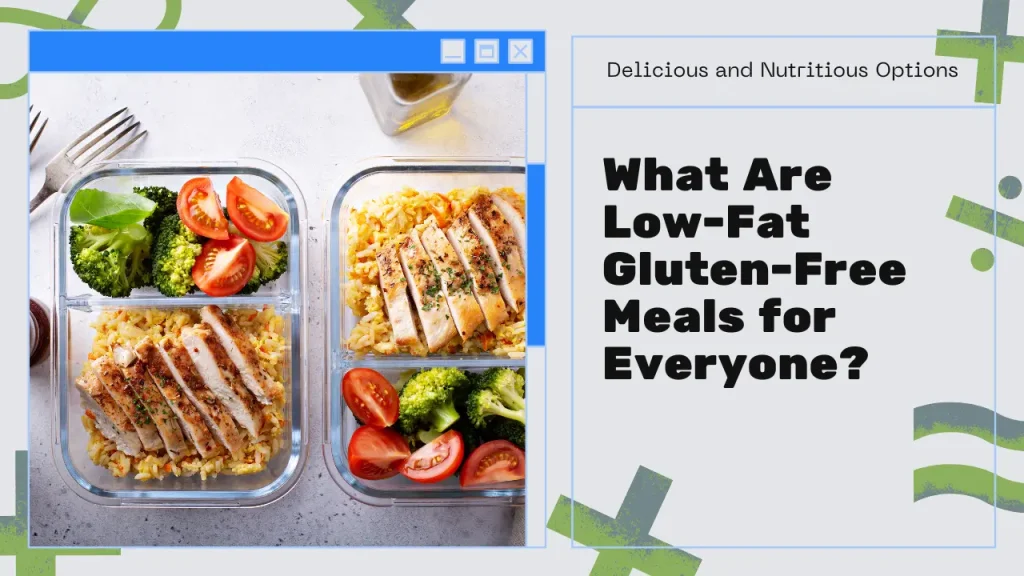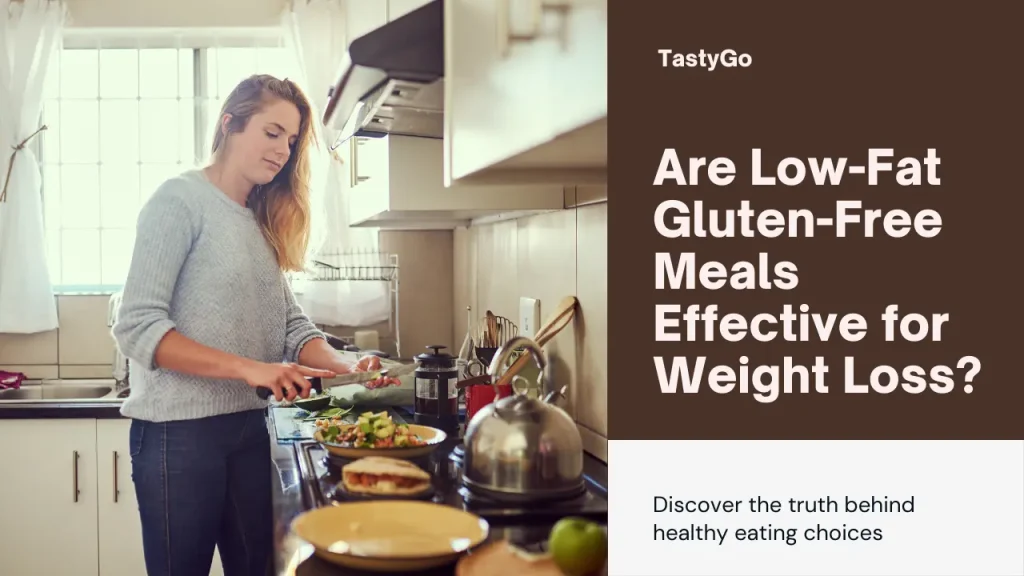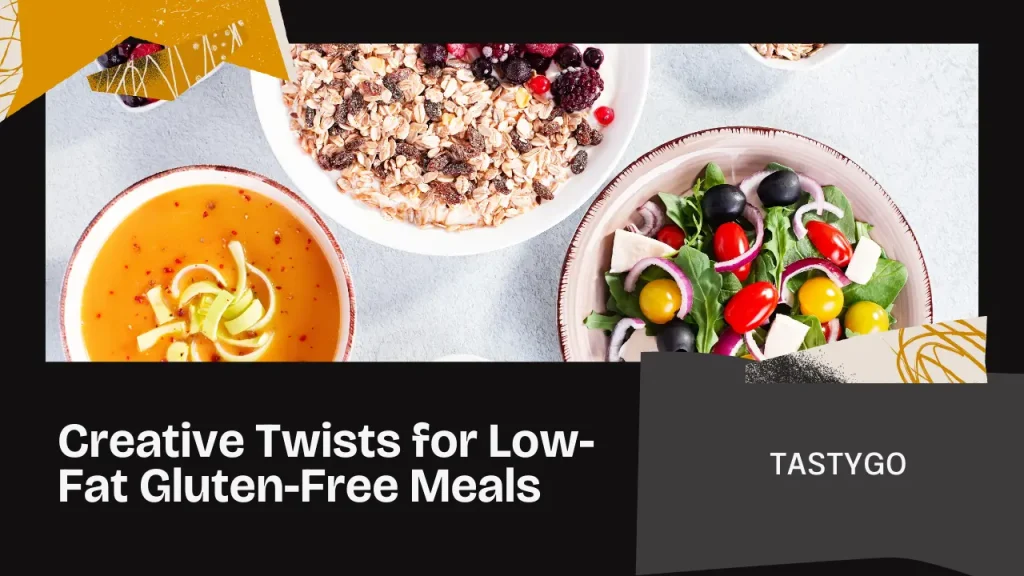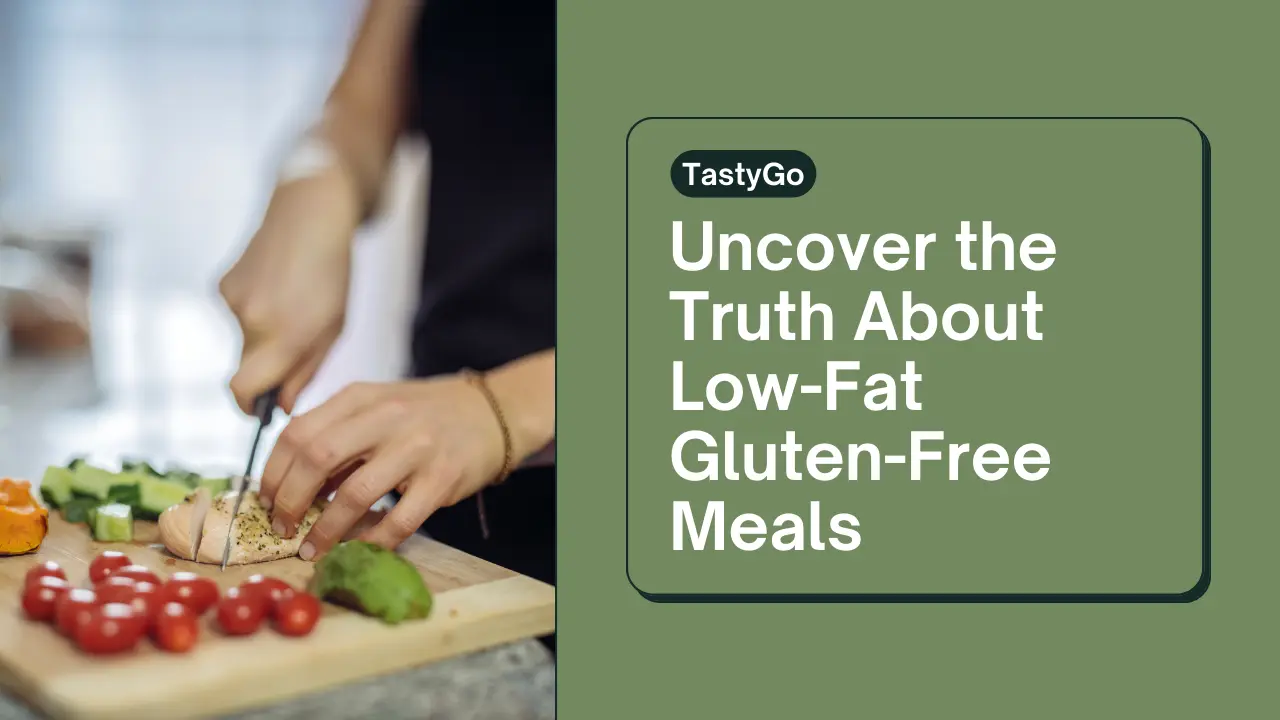Introduction: The Quest for Healthy Eating Made Simple
Let’s face it—navigating dietary restrictions can feel like solving a puzzle. Whether you’re managing celiac disease, trying to shed a few pounds, or simply aiming for a healthier lifestyle, finding meals that are both low-fat and gluten-free might seem daunting. But here’s the good news: it doesn’t have to be complicated.
In this guide, we’ll demystify the world of low-fat gluten-free meals . You’ll learn what they are, why they matter, and how to incorporate them into your daily life without sacrificing flavor or convenience. Plus, I’ll share some easy recipes, practical tips, and answers to your most pressing questions. By the end, you’ll feel empowered to make smarter food choices that work for you .
So grab a cup of tea (or coffee!), and let’s dive in.

What Are Low-Fat Gluten-Free Meals?
Before we get into the nitty-gritty, let’s break it down:
- Low-Fat : These meals are designed to minimize fat content, focusing on lean proteins, whole grains, and nutrient-dense ingredients.
- Gluten-Free : This means no wheat, barley, rye, or any other gluten-containing grains. It’s essential for people with celiac disease or gluten sensitivity but also popular among health-conscious eaters.
When combined, low-fat gluten-free meals offer a double win: they cater to dietary restrictions while promoting overall wellness. Think grilled chicken with quinoa and steamed veggies or a fresh fruit salad topped with Greek yogurt—it’s all about balance.
Pro Tip : Don’t worry; eating gluten-free doesn’t mean giving up your favorite flavors. With a little creativity, you can enjoy meals that are as tasty as they are nutritious.
Why Should You Care About Low-Fat Gluten-Free Meals?
If you’re still wondering whether these meals are worth the effort, here are a few reasons why they might be just what you need:
- Supports Weight Loss : Low-fat options help reduce calorie intake, while gluten-free grains like quinoa and millet keep you full longer.
- Boosts Heart Health : Cutting back on saturated fats lowers cholesterol levels, reducing the risk of heart disease.
- Manages Allergies/Sensitivities : For those with celiac disease or gluten intolerance, avoiding gluten is non-negotiable.
- Encourages Whole Foods : Focusing on fresh produce, lean proteins, and unprocessed ingredients naturally leads to healthier eating habits.
- Versatile and Family-Friendly : Many low-fat gluten-free recipes appeal to a wide range of tastes, making them perfect for family dinners.
Now that you know why these meals matter, let’s talk about how to make them part of your routine.
Foods to Include in Low-Fat Gluten-Free Meals
Building a balanced plate isn’t rocket science. Here’s a quick cheat sheet of foods to focus on:
| Category | Examples |
|---|---|
| Proteins | Chicken breast, turkey, tofu, lentils, eggs |
| Grains | Quinoa, brown rice, millet, buckwheat |
| Vegetables | Spinach, broccoli, zucchini, bell peppers, carrots |
| Fruits | Apples, berries, bananas, oranges |
| Healthy Fats | Avocado, olive oil, nuts (in moderation) |
| Snacks | Rice cakes, veggie sticks, gluten-free protein bars |
These ingredients are not only versatile but also packed with nutrients to fuel your body.

Are Low-Fat Gluten-Free Meals Good for Weight Loss?
Absolutely! If weight loss is your goal, these meals can be a game-changer. Here’s how:
- Lower Calorie Intake : By reducing fat and focusing on whole, minimally processed foods, you naturally consume fewer calories.
- High Fiber Content : Gluten-free grains like quinoa and vegetables provide plenty of fiber, which keeps you feeling full.
- Lean Proteins : Incorporating lean meats, beans, and legumes supports muscle growth and boosts metabolism.
- Reduced Bloating : Many people find that cutting gluten reduces bloating, helping them feel lighter and more comfortable.
Real-Life Example : A client of mine once struggled with stubborn belly fat despite regular exercise. After switching to low-fat gluten-free meals, she noticed significant changes—not just in her weight but also in her energy levels and digestion.
The Science Behind Low-Fat Gluten-Free Eating: Why It Works
Understanding the science behind low-fat gluten-free meals can help you make informed decisions about your diet. Let’s explore why this combination is so effective for health and wellness.
The Role of Fat in Your Diet
Fat is essential for energy, hormone production, and nutrient absorption—but not all fats are created equal. Saturated and trans fats, often found in processed foods, can contribute to weight gain and heart disease. On the other hand, healthy fats like those in avocados and olive oil support brain function and reduce inflammation. By focusing on low-fat meals, you’re cutting out unnecessary calories while still including moderate amounts of beneficial fats.
Why Gluten-Free Matters
For individuals with celiac disease or gluten sensitivity, avoiding gluten is non-negotiable. However, even if you don’t have these conditions, going gluten-free can improve digestion and reduce bloating for some people. Many gluten-free grains, like quinoa and millet, are also rich in fiber and nutrients, making them an excellent choice for a balanced diet.
Synergy Between Low-Fat and Gluten-Free
When combined, low-fat and gluten-free eating creates a powerful duo. For example, swapping high-fat, gluten-heavy foods like pizza or fried chicken for lean proteins and gluten-free grains can stabilize blood sugar levels, improve digestion, and promote long-term health.
Pro Tip : If you’re skeptical about giving up gluten, start small. Replace one meal a week with a gluten-free option and see how your body responds. You might be surprised!
Tools and Ingredients You Need for Low-Fat Gluten-Free Cooking
Preparing low-fat gluten-free meals doesn’t require fancy equipment, but having the right tools and ingredients can make the process smoother and more enjoyable.
Essential Kitchen Tools
- Non-Stick Skillet : Perfect for cooking lean proteins and veggies without adding extra fat.
- Blender : Ideal for making smoothies, soups, or gluten-free baked goods.
- Food Processor : Helps chop veggies quickly and evenly, saving prep time.
- Air Fryer : A game-changer for achieving crispy textures without deep frying.
Must-Have Ingredients
- Gluten-Free Grains : Quinoa, brown rice, buckwheat, and millet are versatile staples.
- Lean Proteins : Chicken breast, turkey, tofu, and lentils provide essential nutrients without excess fat.
- Healthy Fats : Use olive oil sparingly and incorporate avocado or nuts in moderation.
- Fresh Produce : Load up on colorful vegetables and fruits for vitamins, minerals, and fiber.
Organizing Your Kitchen
Before diving into meal prep, organize your pantry and fridge. Dedicate shelves to gluten-free grains and snacks, and keep fresh produce visible so you’re reminded to use it before it spoils. Labeling containers with dates can also help you stay on top of freshness.
Personal Anecdote : When I first transitioned to gluten-free cooking, I underestimated the importance of organization. Once I started labeling my pantry items and keeping a list of go-to recipes, everything became much easier—and less intimidating.
Weekend Prep Routine: A Step-by-Step Guide to Low-Fat Gluten-Free Success
If you’ve ever thought, “I don’t have time to cook healthy meals,” let me assure you—it’s easier than you think. With a little planning, you can knock out a week’s worth of low-fat gluten-free meals in just a couple of hours over the weekend. Here’s how:
Step 1: Plan Your Menu
Start by deciding what you want to make for the week. Aim for a mix of breakfast, lunch, dinner, and snacks. For example:
- Monday Dinner: Lemon herb grilled chicken with quinoa salad
- Tuesday Lunch: Veggie-packed stir-fry with tofu
- Wednesday Snack: Rice cakes with almond butter
Step 2: Gather Ingredients and Tools
Make a shopping list based on your menu and stock up on essentials like fresh produce, lean proteins, and gluten-free grains. Lay out your tools (skillet, blender, etc.) before you begin to save time.
Step 3: Batch Cook and Assemble
Dedicate one day—Saturday or Sunday—to prep everything. Here’s a sample timeline:
- 9:00 AM: Roast vegetables and cook quinoa for salads.
- 9:45 AM: Grill chicken breasts and portion them into containers.
- 10:30 AM: Blend a batch of smoothies and freeze them in individual portions.
- 11:15 AM: Clean up and store everything in the fridge or freezer.
Step 4: Create a Checklist
To stay organized, use this simple checklist:
- Plan menu
- Shop for ingredients
- Prep and cook meals
- Store properly
Why It Works : I used to dread meal prep because I didn’t know where to start. Once I created a routine and stuck to it, cooking became less stressful and more rewarding. Plus, knowing I had healthy meals ready to go made sticking to my goals much easier.

Creative Twists to Keep Your Low-Fat Gluten-Free Meals Exciting
Let’s face it—eating the same meals every day can get boring. The good news? You don’t have to stick to plain grilled chicken and steamed broccoli. Here are some creative ways to spice up your low-fat gluten-free meals:
Global-Inspired Flavors
Experiment with cuisines from around the world to keep things interesting. For example:
- Mexican : Make gluten-free tacos with black beans, grilled fish, and salsa.
- Asian : Whip up a low-fat pad thai using zucchini noodles and shrimp.
- Mediterranean : Serve hummus with veggie sticks and gluten-free pita bread.
Seasonal Ingredients
Take advantage of seasonal produce to keep your meals fresh and exciting. In the fall, try roasted squash with quinoa and cranberries. In summer, go tropical with mango salsa and grilled chicken.
Fun Snacks and Desserts
Who says snacks and desserts can’t be healthy? Try these ideas:
- Chocolate Avocado Mousse : Blend ripe avocado with cocoa powder and a touch of honey for a creamy treat.
- Baked Apple Chips : Slice apples thinly, sprinkle with cinnamon, and bake until crispy.
- Chia Seed Pudding : Mix chia seeds with almond milk and top with fresh berries.
Reader Challenge : Next time you prep, try swapping one ingredient in your usual recipe for something new. Maybe it’s swapping peanut butter for almond butter or adding a dash of chili flakes to your stir-fry. Small changes can make a big impact on flavor and excitement.
FAQs About Low-Fat Gluten-Free Meals
Here are answers to some common questions to clear up any confusion:
Q1: What are low-fat gluten-free meals?
A1: These are meals made without gluten and low in fat, ideal for healthy and allergy-friendly diets.
Q2: Are low-fat gluten-free meals good for weight loss?
A2: Yes, they can support weight loss by reducing calorie and fat intake while avoiding gluten.
Q3: What foods are included in low-fat gluten-free meals?
A3: Vegetables, lean meats, rice, legumes, fruits, and gluten-free grains like quinoa or millet.
Q4: Can I eat out on a low-fat gluten-free diet?
A4: Yes, many restaurants offer gluten-free and low-fat options—just ask for ingredient details.
Q5: Are low-fat gluten-free meals suitable for everyone?
A5: They’re great for those with gluten intolerance or those seeking a lighter, healthier diet.
Q6: How do I start cooking low-fat gluten-free meals?
A6: Use fresh, whole foods and avoid processed items. Focus on lean proteins and gluten-free grains.
Q7: Are there low-fat gluten-free snacks available?
A7: Yes, options include fruit, rice cakes, veggie sticks, and gluten-free protein bars.
Tips for Making Low-Fat Gluten-Free Meals Easier
If you’re new to this way of eating, don’t stress—I’ve got you covered with these practical tips:
- Plan Ahead : Spend 10 minutes each week planning your meals. This saves time and reduces decision fatigue.
- Stock Your Pantry : Keep staples like quinoa, canned beans, and gluten-free pasta on hand.
- Batch Cook : Prepare large portions of soups, stews, or casseroles and freeze them for busy nights.
- Experiment with Herbs and Spices : Add flavor without extra fat using garlic, ginger, turmeric, or cumin.
- Read Labels Carefully : Even seemingly “healthy” products may contain hidden gluten or added fats.
Personal Anecdote : When I first started experimenting with gluten-free cooking, I was overwhelmed by the idea of giving up bread and pasta. But then I discovered zucchini noodles and cauliflower rice—they’ve become staples in my kitchen ever since!
Easy Low-Fat Gluten-Free Recipes to Try Tonight
Ready to get cooking? Here are three simple recipes to kickstart your journey:
1. Lemon Herb Grilled Chicken with Quinoa Salad
- Why You’ll Love It : Packed with protein and fiber, this dish is light yet satisfying.
- How to Make It : Marinate chicken breasts in lemon juice, olive oil, and herbs. Grill until cooked through. Serve over a bed of quinoa mixed with diced cucumbers, tomatoes, and parsley.
2. Veggie-Packed Stir-Fry with Tofu
- Why You’ll Love It : Vegan, gluten-free, and loaded with antioxidants.
- How to Make It : Sauté tofu cubes with broccoli, bell peppers, snap peas, and carrots. Season with tamari (gluten-free soy sauce) and ginger.
3. Berry Yogurt Parfait
- Why You’ll Love It : A sweet treat that’s guilt-free and perfect for breakfast or dessert.
- How to Make It : Layer Greek yogurt with sliced strawberries, blueberries, and a sprinkle of granola.
Can You Eat Out on a Low-Fat Gluten-Free Diet?
Yes, dining out is totally doable—you just need to be mindful. Here’s how:
- Research Ahead : Check restaurant menus online to see if they offer gluten-free and low-fat options.
- Ask Questions : Don’t hesitate to ask servers about ingredients or preparation methods.
- Customize Your Order : Request dressings on the side, skip fried foods, and substitute high-fat sides with veggies or salads.
Conclusion: Your Path to Healthier Eating Starts Now
Eating low-fat gluten-free meals doesn’t mean sacrificing taste or variety. With the right ingredients, a little planning, and some creativity, you can enjoy delicious, nutritious meals that align with your goals and lifestyle.
Whether you’re managing a medical condition, aiming to lose weight, or simply exploring healthier eating habits, these meals are a fantastic choice. So why wait? Start small—swap one meal today—and watch how it transforms your health and happiness.
Got a favorite low-fat gluten-free recipe? Share it in the comments below—I’d love to hear from you!

